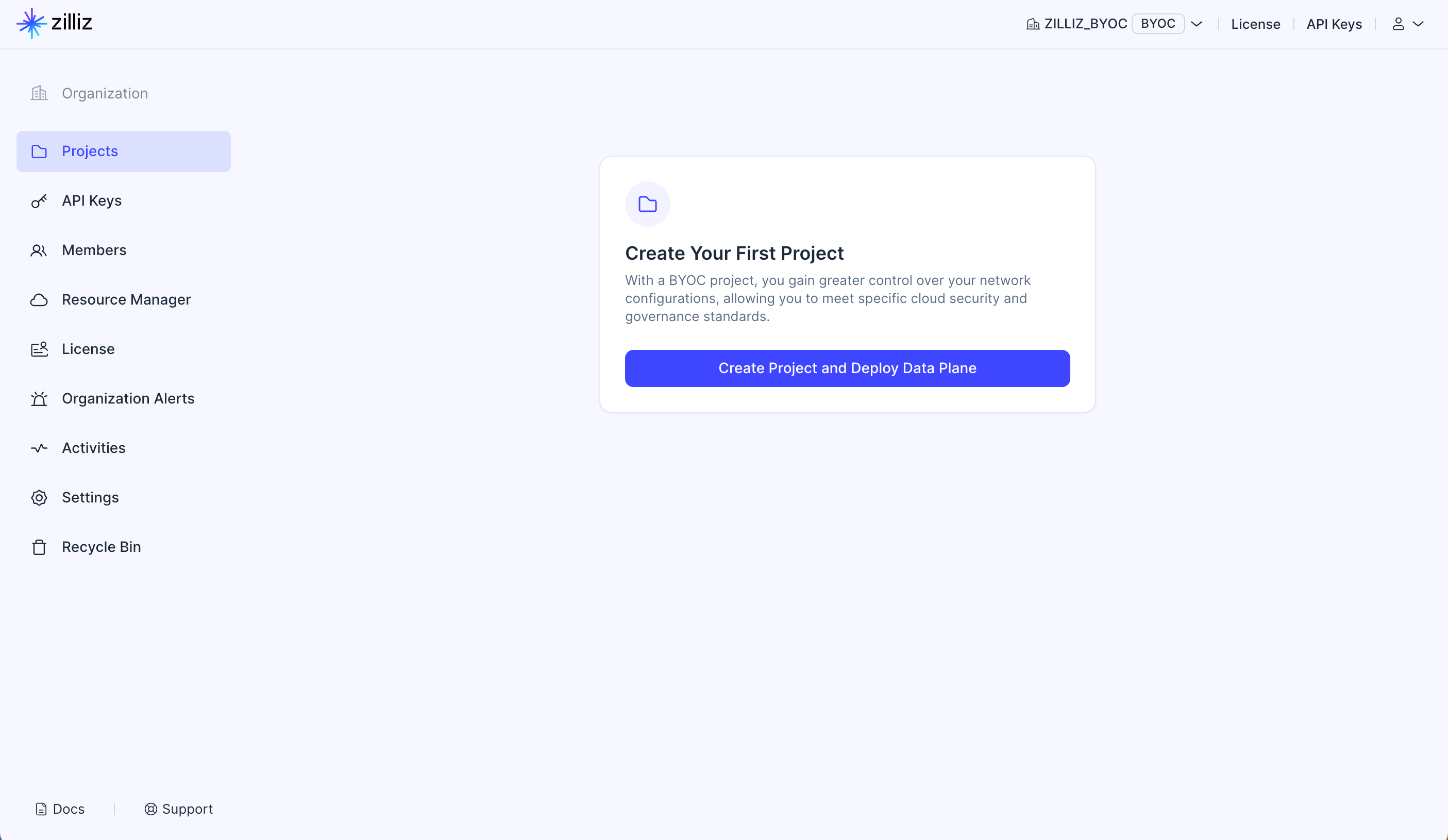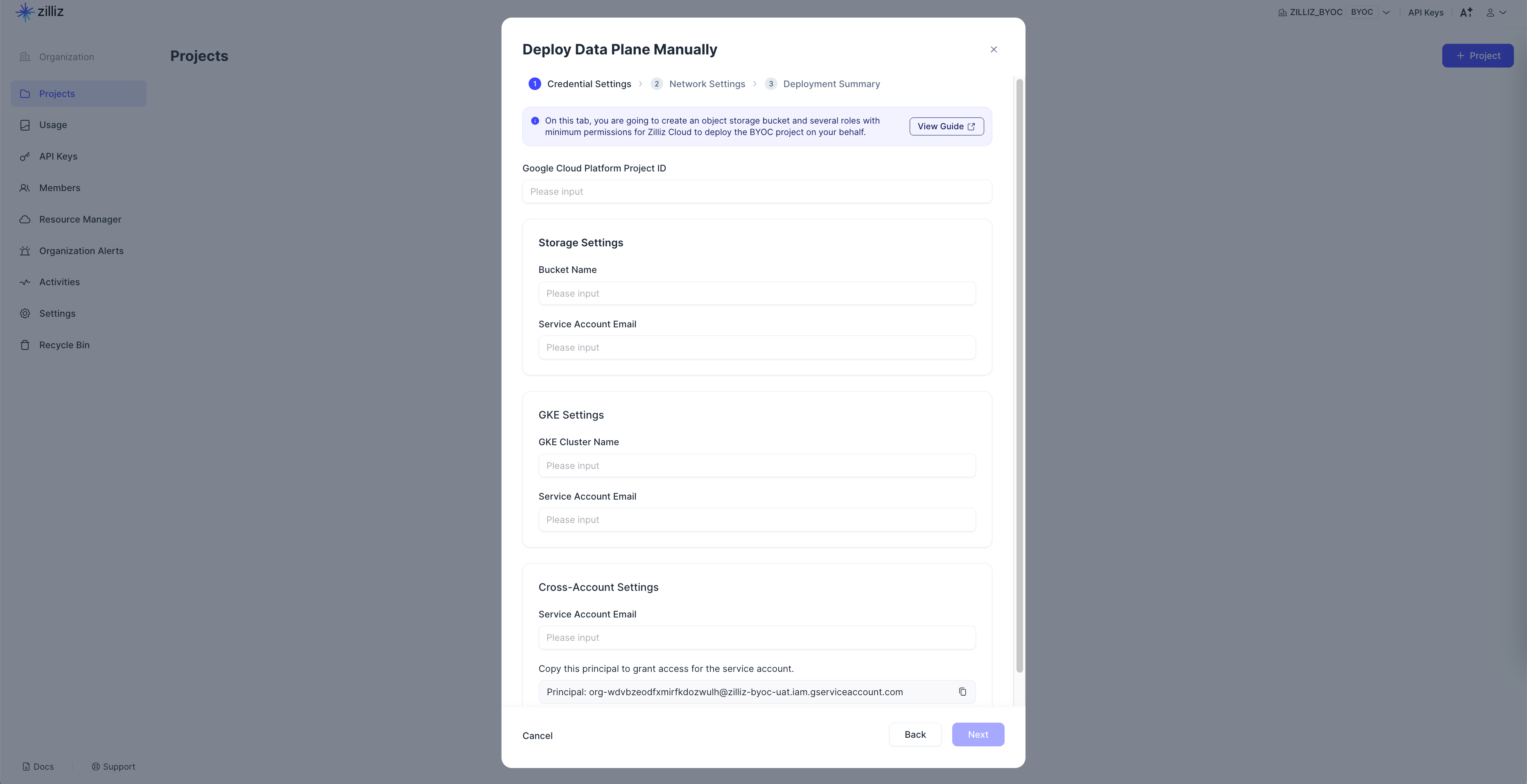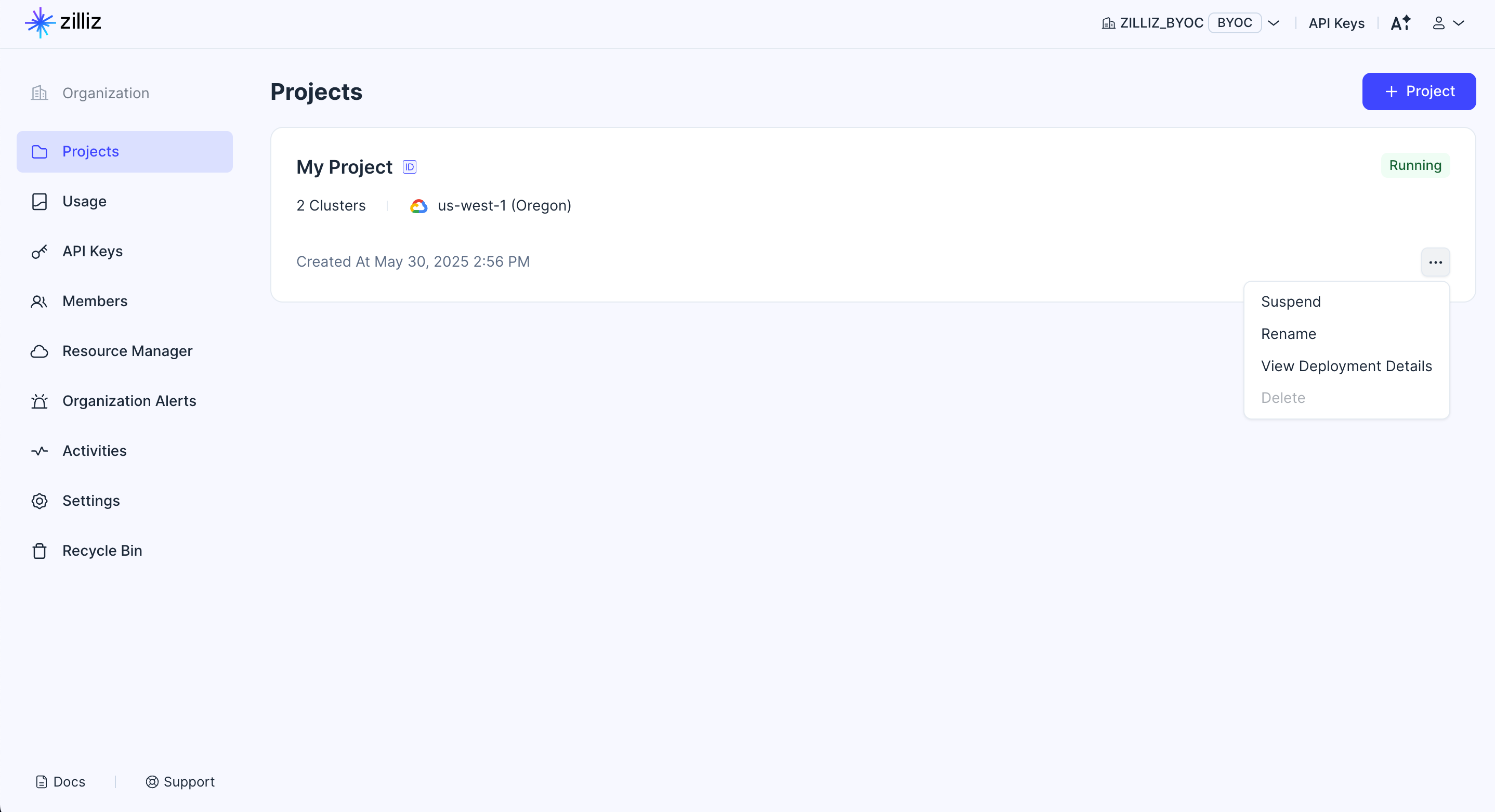GCP に BYOC を展開
このページでは、Zilliz Cloud コンソールとカスタム GCP 構成を使用して、Google Cloud Platform (GCP) Virtual Private Cloud (VPC) に完全に管理された Bring-Your-Own-Cloud (BYOC) データプレーンを手動で作成する方法について説明します。
Zilliz BYOC は現在、一般提供されています。アクセスおよび実装の詳細については、Zilliz Cloud 営業担当にお問い合わせください。
このガイドでは、AWS コンソールで必要なリソースをステップバイステップで作成する方法を示しています。インフラストラクチャをプロビジョニングするために Terraform スクリプトを使用する場合は、Terraform プロバイダーを参照してください。
前提条件
-
BYOC 組織の所有者でなければなりません。
-
必要な GCP API サービス を有効にしています。
手順
GCP に BYOC を展開するには、Zilliz Cloud が代理で Cloud Storage バケットと顧客管理 VPC 内の GKE クラスターにアクセスするために特定のロールを想定する必要があります。したがって、Zilliz Cloud は Cloud Storage バケット、GKE クラスター、VPC の情報およびこれらのインフラストラクチャリソースにアクセスするために必要なロールを収集する必要があります。
BYOC 組織内で プロジェクトを作成してデータプレーンを展開 ボタンをクリックして展開を開始します。

ステップ1: プロジェクトを作成
このステップでは、Zilliz BYOC プロジェクト名を設定し、クラウドプロバイダーとリージョン、および展開の初期プロジェクトサイズを決定します。

-
Zilliz BYOC プロジェクト名 を設定します。
-
クラウドプロバイダー および クラウドリージョン を選択します。
-
GCP プライベートサービスコネクト を有効にするかどうかを決定します。
このオプションにより、現在のプロジェクト内のクラスターへのプライベート接続が可能になります。このオプションを有効にする場合は、プライベート接続用にプライベートサービスコネクトエンドポイントを作成する必要があります。
-
アーキテクチャ で、アプリケーションに一致するアーキテクチャタイプを選択します。
これにより、使用する Zilliz BYOC イメージのアーキテクチャタイプが決定されます。利用可能なオプションは X86 および ARM です。
-
リソース設定 では、
-
自動スケーリング を有効または無効にして、Zilliz Cloud がプロジェクトワークロードに基づいて定義された範囲内で EC2 インスタンスの数を自動的に調整できるようにします。
-
初期プロジェクトサイズ を構成します。
BYOC プロジェクトでは、クエリノード、インデックスサービス、Milvus コンポーネント、および依存関係が異なる Google Compute Engine (GCE) インスタンスを使用します。これらのサービスおよびコンポーネントのインスタンスタイプを設定できます。
自動スケーリング が無効になっている場合は、対応する 数 フィールドに各プロジェクトコンポーネントに必要な GCE インスタンスの数を指定するだけです。

自動スケーピング が有効になると、実際のプロジェクトワークロードに基づいて GCE インスタンスの数を自動的にスケーリングするために、対応する 最小 および 最大 フィールドを設定して Zilliz Cloud が使用する範囲を指定する必要があります。

リソース設定を容易にするために、4つの事前定義されたプロジェクトサイズオプションがあります。以下の表は、これらのプロジェクトサイズオプションとプロジェクトで作成できるクラスターの数、およびこれらのクラスターが含むことができるエンティティ数との対応を示しています。
サイズ
最大クラスター数
最大エンティティ数 (百万)
パフォーマンス最適化 CU
容量最適化 CU
小
8〜16 CU の 3 クラスター
1000万 - 2500万
4000万 - 8000万
中
16〜64 CU の 7 クラスター
2500万 - 1億
8000万 - 3.5億
大
64〜192 CU の 12 クラスター
1億 - 3億
3.5億 - 10億
特大
192〜576 CU の 17 クラスター
3億 - 9億
10億 - 30億
初期プロジェクトサイズ で カスタム を選択し、すべてのデータプレーンコンポーネントの GCE インスタンスタイプおよび数を調整することで、設定をカスタマイズすることもできます。お好みの GCE インスタンスタイプがリストにない場合は、追加の支援のためにZilliz サポートまでお問い合わせください。
-
-
次へ をクリックして認証情報を設定します。
ステップ2: 認証情報を設定
認証設定 では、ストレージとストレージアクセス、GKE クラスターマネジメント、およびデータプレーン展開用の複数のサービスアカウントを設定する必要があります。

-
Google Cloud Platform プロジェクト ID で、GCP プロジェクトの ID を入力します。
-
ストレージ設定 で、GCP から取得した バケット名 および サービスアカウントメール を設定します。
Zilliz Cloud は、指定したバケットをデータプレーンストレージとして使用し、指定したサービスアカウントを使用して代理でアクセスします。
バケットの設定とサービスアカウントの作成の詳細については、Cloud Storage バケットとサービスアカウントの作成を参照してください。
-
GKE 設定 で、GKE マネジメント用の GKE クラスター名 および サービスアカウントメール を設定します。
Zilliz Cloud は、指定したサービスアカウントを使用して指定した名前の GKE クラスターを代理で展開し、GKE クラスターにデータプレーンを展開します。
サービスアカウントの作成の詳細については、GKE サービスアカウントの作成を参照してください。
-
クロスアカウント設定 で、データプレーン展開用の サービスアカウント名 を設定します。
サービスアカウントの準備ができたら、下記の読み取り専用テキストボックスに表示されている Zilliz BYOC プリンシパルをコピーして、GCP コンソールに貼り付けて、Zilliz Cloud BYOC プロジェクトのデータプレーンを展開するための必要な権限を Zilliz BYOC に付与します。
クロスアカウントサービスアカウントの作成の詳細については、クロスアカウントサービスアカウントの作成を参照してください。
-
次へ をクリックしてネットワーク設定を構成します。
ステップ3: ネットワーク設定を構成
ネットワーク設定 では、VPC とサブネット名、およびオプションのプライベートサービスコネクトエンドポイントなど、複数のタイプのリソースを作成します。

-
ネットワーク設定 で、VPC 名、サブネット名、およびオプションの プライベートサービスコネクトエンドポイント を設定します。
指定した VPC で Zilliz Cloud には以下のものが必要です。
-
2つのセカンダリサブネットを持つプライマリサブネット、
-
ロードバランサーサブネット、および
-
オプションのプライベートサービスコネクトエンドポイント。
プライベートサービスコネクトエンドポイント は、上記の 全般設定 で GCP プライベートサービスコネクト をオンにした場合にのみ利用可能であることに注意してください。
-
-
次へ をクリックして要約を表示します。
-
展開要約 で、構成設定を確認します。
-
すべてが期待通りであれば、作成 をクリックします。
展開の詳細を表示
プロジェクトを作成した後、プロジェクトページでそのステータスを表示できます。

一時停止 & 再開
プロジェクトを一時停止すると、データプレーンが停止し、プロジェクトをサポートする GKE クラスターに関連付けられたすべての GCE インスタンスが終了します。この操作は、プロジェクト内の一時停止された Zilliz Cloud クラスターには影響せず、データプレーンが復元されれば再開できます。

プロジェクトが実行中の場合、プロジェクト内にクラスターが存在しないか、すべてのクラスターがすでに一時停止している場合にのみプロジェクトを一時停止できます。

プロジェクトカードのステータスタグが 一時停止中 と表示されると、プロジェクト内のクラスターを操作できなくなります。その場合は、再開 をクリックしてプロジェクトを再開できます。ステータスタグが再び 実行中 に変わるまで、プロジェクト内のクラスターを操作し続けることができます。

手順
Cloud Storage バケットとサービスアカウントの作成 [READ MORE]
このページでは、Bring-Your-Own-Cloud (BYOC) プロジェクトのルートストレージを作成および構成する手順と適切な権限について説明します。
GKE サービスアカウントの作成 [READ MORE]
このページでは、Zilliz Cloud が Zilliz Cloud プロジェクト用に Google Kubernetes Engine (GKE) クラスターを展開するためのサービスアカウントを作成および構成する方法について説明します。
クロスアカウントサービスアカウントの作成 [READ MORE]
このページでは、Zilliz Cloud がプロジェクトデータプレーンをブートストラップするためのクロスアカウントサービスアカウントを作成および構成する方法について説明します。このサービスアカウントにより、Zilliz Cloud は代理で VPC リソースを管理するための必要な権限を付与されます。
GCP 上の顧客管理 VPC の構成 [READ MORE]
Zilliz Cloud Bring-Your-Own-Cloud (BYOC) ソリューションにより、独自の Virtual Private Cloud (VPC) 内にプロジェクトを設定できます。顧客管理 VPC で実行される Zilliz Cloud プロジェクトでは、ネットワーク構成をより制御できるため、組織が必要とする特定のクラウドセキュリティおよびガバナンス基準を満たすことができます。
必要な権限 [READ MORE]
このページでは、VPC ネットワーク上に Zilliz BYOC データプレーンを展開中に必要な IAM ポリシーを一覧表示します。
必要な GCP API サービス [READ MORE]
このページでは、Zilliz Cloud Terraform プロバイダーを使用して GCP リスを作成するために必要な Google Cloud Platform (GCP) API サービスを一覧表示し、それらを有効にするいくつかの方法を提供します。